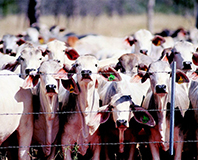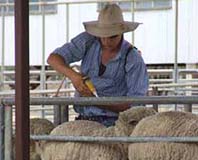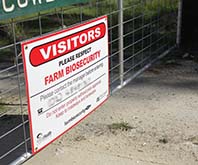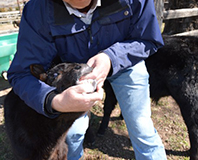Read the latest information on
Foot-and-mouth disease
Every property has different biosecurity risks, which is why no two biosecurity plans are the same, and there’s no point spending the time and effort to make a plan that isn’t put into practice. This article highlights some key ways you can strengthen your overall biosecurity, reducing the disease, pest and/or weed risk to your business whilst strengthening Australia’s overall agricultural industries at the same time.
 Incoming livestock arguably present the biggest risk for the spread of disease onto your property. Incoming livestock, including new purchases and livestock returning from agistment, shows or events, can all bring pests and weeds with them.
Incoming livestock arguably present the biggest risk for the spread of disease onto your property. Incoming livestock, including new purchases and livestock returning from agistment, shows or events, can all bring pests and weeds with them.
Keeping these livestock separated on arrival reduces contact with other livestock or animals (the key transmission event for many diseases) and allows you to monitor a contained area for signs of disease, weed germination or pest incursion.
Ideally, incoming livestock should be kept isolated for three weeks. This allows time for most diseases to develop enough for you to see signs of illness. If three weeks is not possible, allowing at least a week will still be enough time for signs of many diseases to show and allow for unwanted weed seeds to pass through the gut of livestock in the containment area and not over the broader property.
During the time that livestock is segregated, it is important to monitor them for signs of ill health. You can also monitor the area for signs of germination of new weeds or pests. Monitoring of the area should be done during the time that livestock are held and for the weeks following to make sure germination of weed seeds are detected and addressed early.
 A strong animal health program can significantly reduce the impacts of endemic disease on your property. Know what diseases are endemic to your area, what vaccines and treatments are available and what the treatment history is for purchased livestock. This will ensure that your animal health program doesn’t double up on treatments and is relevant to your region.
A strong animal health program can significantly reduce the impacts of endemic disease on your property. Know what diseases are endemic to your area, what vaccines and treatments are available and what the treatment history is for purchased livestock. This will ensure that your animal health program doesn’t double up on treatments and is relevant to your region.
You can collect information on the treatments and health status of purchased animals using the National Vendor Declaration (NVD) and an Animal Health Declaration (available on the Farm Biosecurity website). You can also request information from the seller or state agency staff if you want further information on specific diseases present in the area from which the animals have come.
 People and vehicles coming on and off your property also pose a risk to your property biosecurity. Whilst some people may have a right to access (e.g. utility workers), you can remind them of your property biosecurity expectations and access procedure.
People and vehicles coming on and off your property also pose a risk to your property biosecurity. Whilst some people may have a right to access (e.g. utility workers), you can remind them of your property biosecurity expectations and access procedure.
This can be done easily through the use of a biosecurity gate sign. These can be custom made to suit your requirements or you can download a free template or order a standard sign from the Farm Biosecurity website.
Some examples of an access procedure may be to ask visitors to phone before entry to the property (or if signal-strength is a problem, UHF radio may be an alternative) or ask them to report to the house, stay on designated roads, or keep out of production areas.
By doing so it gives you an opportunity to work with them toward a positive outcome which satisfies your biosecurity expectations and their access needs.
 Regularly monitoring stock for signs of disease, pastures for germination of new weeds, and your property for signs of pest animals can greatly enhance your property biosecurity. Detecting a problem early can assist in treatment, isolation and management: in some cases greatly reducing the cost of the problem and the time it takes to solve. We all know a stitch in time, saves nine!
Regularly monitoring stock for signs of disease, pastures for germination of new weeds, and your property for signs of pest animals can greatly enhance your property biosecurity. Detecting a problem early can assist in treatment, isolation and management: in some cases greatly reducing the cost of the problem and the time it takes to solve. We all know a stitch in time, saves nine!
Monitoring is important not only for endemic diseases, but also in response to emergency animal disease outbreaks. Early detection and reporting in these circumstances will greatly increase Australia’s ability to contain and eradicate an exotic disease outbreak.
 Record keeping is no-one’s favourite job, but running a business means there will always be paperwork to do. Being able to show how your property biosecurity works in practice and prove what you say you’ve done is increasingly important. In the event of a pest or disease outbreak, records allow for tracing back to the root cause as well as isolating other properties that may have been impacted so it can be contained quickly.
Record keeping is no-one’s favourite job, but running a business means there will always be paperwork to do. Being able to show how your property biosecurity works in practice and prove what you say you’ve done is increasingly important. In the event of a pest or disease outbreak, records allow for tracing back to the root cause as well as isolating other properties that may have been impacted so it can be contained quickly.
Records also help you support your food safety requirements. Livestock production is the first link in the food supply chain and consumers and others (e.g. processors) increasingly expect that food safety is built into the products they are trading or buying.
If you would like more information on biosecurity planning for livestock, please contact your local AHA extension manager.